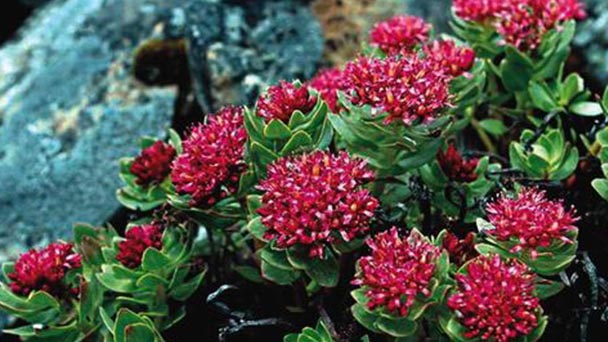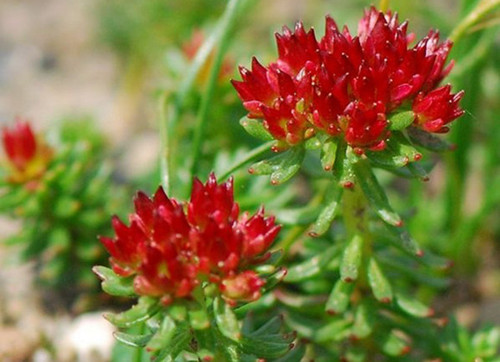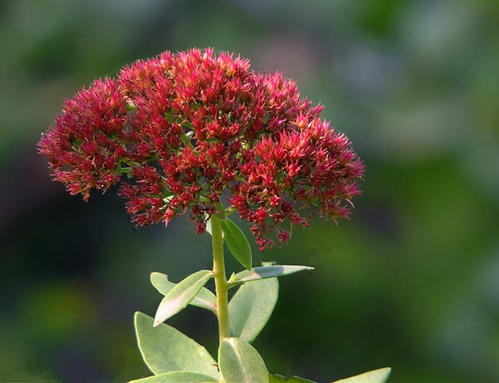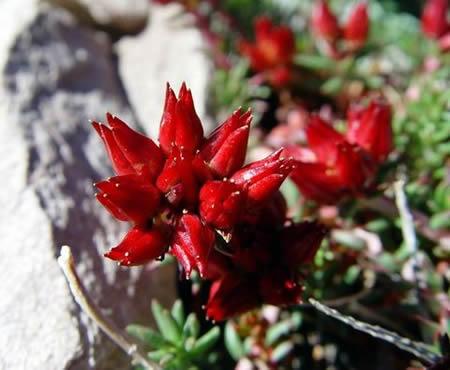Rhodiola rosea profile
Written by Maggie
Feb 09 2021

Rhodiola rosea is a perennial herb with a height of 10-20 cm. Rhodiola rosea roots are stout, conical, fleshy, brownish yellow, root neck with many fibrous roots, rhizome short, thick, cylindrical, with many imbricate arranged scaly leaves. Growing in the alpine pollution-free zone of 1800-2500 meters above sea level, the growing environment is harsh, so it has strong vitality and special adaptability. Rhodiola rosea can be used as medicine, can replenish qi, clear the lung, and nourish the mind. It is a traditional Chinese medicine with a wide range of effects. Rhodiola rosea also has the very big beauty effect, and can make the skin care product, also can eat.
Rhodiola rosea picture

Rhodiola rosea morphological characteristics
Rhodiola rosea is a perennial herb. Roots are stout, erect. Root neck short, apex scaly. The flower stem is 20-30 cm tall. Leaves of Rhodiola rosea are sparsely grown, oblong to elliptic oblanceolate or oblong-broadly ovate, 7-35 mm long, 5-18 mm wide, apex acute or acuminate, entire or distally with a few teeth, base slightly branched.
Inflorescences are corymbiform, densely flowered, 2 cm long and 3 -- 6 cm wide; Dioecy; Rhodiola rosea has 4 sepals, lanceolate linear, 1 mm long, obtuse; Rhodiola rosea has 4 petals, yellowish green, linear-oblanceolate or oblong, 3 mm long, obtuse; Stamens 8 in male flowers, longer than petals; Rhodiola rosea has 4 scales, oblong, 1-1.5 mm long, 0.6 mm wide, distally slightly narrow, apex dentate; Female flowers center lenticel 4, style obturate.
Follicles of Rhodiola rosea are lanceolate or linear-lanceolate, erect, 6-8 mm long, beak 1 mm long; Seeds are lanceolate, 2 mm long, narrowly winged on one side.
Rhodiola rosea growth habit
Growing in the alpine pollution-free zone of 1800-2500 meters on the slopes of forests or grassy slopes rare wild plants, Rhodiola rosea is mostly distributed in the northern hemisphere of the alpine zone. Rhodiola rosea has strong vitality and special adaptability due to its harsh growing environment, such as lack of oxygen, low temperature and dryness, strong wind, exposure to ultraviolet radiation, and large temperature difference between day and night.
Rhodiola rosea distribution range
Rhodiola rosea is distributed in Heilongjiang, Jilin, Xizang and northwest Yunnan, Ningxia, Gansu, Qinghai, Sichuan and other places; In northern Europe to Russia, Mongolia, Korea, Japan, Rhodiola rosea is also distributed.
Rhodiola rosea propagation methods
Propagation method Propagation by seeds or rhizomes.
Seed propagation, seedling transplanting method. The seed is fine, the 1000 grain weight is 0.13-0.15g, the suitable germination temperature is 15-20℃,
Storage for 1 year loss of germinating power. Selecting mature and full new seeds of Rhodiola rosea, soaking them with gibberellin and ABT root powder could promote germination and rooting, and the emergence rate.
Rhizome propagation of Rhodiola rosea, combined with harvest, selects a larger rhizome, cut into 3-5cm small sections, slightly dry 1-2d, so that the wound heals.

How to grow and care for Rhodiola rosea
Choose place to grow
Rhodiola Rosa is generally wild on sunny slopes, rock crevices, alpine meadows, alpine rock crevices and hillside grasses
Rhodiola rosea form
In the ground, scrub margins, and dry sandy soils of high mountains. Rhodiola rosea has strong adaptability, likes slightly cold and wet climatic conditions, cold and drought resistance, and is not very strict with soil requirements. Rhodiola rosea should be cultivated in the mountainous areas with higher altitude, cold climate, short frost-free period and large temperature difference between day and night in summer.
Cultivation should choose the loam or sandy loam with abundant humus, deep soil layer, sufficient sunlight and good drainage, and can be cultivated on the mountain forest cut or waste land.
Seedling of Rhodiola rosea had better choose soil quality fertile loose, close to the water source plot.
As far as possible, we should choose hill slopes with good drainage and slightly more sand in the soil, barren hill slopes and non-cultivated land for transplanting, and Rhodiola rosea is not suitable for cultivation in clay, saline-alkali soil and low-lying water.
Site preparation fertilization
After the selection of land for Rhodiola rosea, deep turn 30~40cm, remove field debris, break soil blocks, along the slope to make the bed, bed width 100~120cm, 20~25cm high, work road width 50~70cm, combined with the cultivated land, each hectare into the barnyard manure or pig manure 30,000 ~ 50,000 kg, compound fertilizer 20~30 kg, rake leveling. The ground with higher terrain can be furred, the land with lower terrain can also be rigid, the slopes and slopes of non-cultivated land only ploughing and raking fine, do not make furrows do not, but to dig drainage ditches.
Seedling
Sow fresh, ripe rhodiola rosea seeds in the spring or fall to just before freezing. Autumn sowing seedling early, seedling whole, seeds do not need to deal with.
When sowing Rhodiola rosea in spring, seeds should be immersed in water. The specific method is to concentrate the seeds into a clean cloth bag, soak the bag in room temperature water for 40~50h, change the water 2~4 times a day, soak the seeds in a cool and ventilated place to dry the surface water, and sow the seeds of Rhodiola rosea when they can disperse naturally. When sowing, first use the board to scrape the surface soil of the nursery bed, according to the row distance of 8~10cm cross furrow, furrow depth of 3~5mm, the seeds are evenly scattered in the furrow, sowing 1 per square meter.5 ~ 2.0g, cover the screened fine soil 2~3mm, with the hand or board will be compacted, and then cover the bed with a layer of straw or pine branches to keep wet.
Transplanting
Rhodiola rosea seedlings were transplanted after 1 year of growth, after the aboveground parts had withered in the autumn of the same year or before they turned green in the spring of the next year. The effect of transplanting is better in spring.
Harvesting and processing
Wither above ground in the autumn harvest season, first remove the aboveground withered leaf of Rhodiola rosea, dug out of underground part, remove dirt, rinse clean with water, under the condition of 60 ~ 70 ℃ drying, or herbs will wash pot steamed on 7 ~ 10 minutes later, dried in the sun or in dry indoor drying, reach seven and eighty percent for medicine works, the root and rhizome of Rhodiola rosea whole straightening, the top alignment, a number of rhizome bales into small, baking to dry.
Rhodiola rosea pest control
Disease mainly occurs in the Rhodiola rosea rhizome propagation seedling incision, easy to form root rot, before transplanting disinfection and sterilization can be prevented. The main insect pests of Rhodiola rosea are aphids and small red beadle and other lepidopteran pests, using environmental protection insecticide 3% hyperosmotic fenoxycarb EC0.025%~0.033% solution spray control.
Rhodiola rosea medicinal value
Rhodiola rosea has the effect of replenishing qi and clearing lungs, nourishing mind, astringent hemostasis, dispersing blood stasis and detumescent. The main treatment is deficiency, body weakness, chills after the disease, shortness of breath, lung heat cough, hemoptysis, leucorrhea, injury and so on.

Latest Updated
- Benefits of Bugleweed - 7 Science-backed Health Benefits
- Bugleweed Dangers & Side Effects - Is It Poisonous?
- How to Plant Evergreen Trees - What You Should Know
- When to Plant Evergreens - Grow Guide for Evergreen Trees
- 12 Wonderful Evergreen Shrubs for Your Garden
- 12 Popular Evergreen Plants with Pictures for Beginners
- When And How To Prune A Lilac Bush Like a Pro
- How to Grow & Care for Lilac Vine (Hardenbergia Violacea)
- Japanese Lilac Tree (Syringa Reticulata) Care & Propagation Guide
- Shumard Oak Pros and Cons - What to Know
Popular Articles
- Winter maintenance of Antirrhinum Majus
- How to Grow Terminalia Mantaly Tree
- How to Grow and Care for Crossostephium Chinense
- How to grow Antirrhinum Majus in spring
- Peristeria Elata (Dove Orchid) Profile: Info & Care Guide
- Underwatered Snake Plant (Sansevieria Trifasciata) - Signs And How To Fix
- How to Care for Brazilian Jasmine Plant (Mandevilla Sanderi)
- How to Grow & Care for Graptopetalum Purple Delight in Summer
- Rosa Chinensis (China Rose): Plant Growing & Care Tips
- How to Care for Baby Sun Rose (Aptenia Cordifolia)